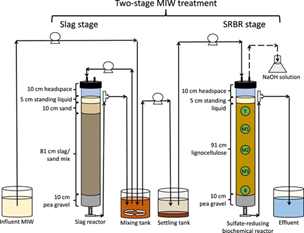A consistent environmental challenge presented at mining sites worldwide is the formation of mining-influenced water (MIW). Characterized by alterations in water chemistry due to mining or mineral processing, MIW streams are typically acidic and often contain elevated concentrations of heavy metals and metalloids, which may pose a threat to human health, ecology and water resources. Sulfate reducing biochemical reactors (SRBRs) are most often used to passively treat MIW, however, they suffer from pH issues as well as longevity and efficacy issues. Significant advances toward more effective and streamlined water treatment solutions need to be developed.
Researchers at Arizona State University in collaboration with industry leaders have designed a novel two-stage treatment for MIW in which basic oxygen furnace slag (slag stage) and microbial SO42– reduction (SRBR stage) are incorporated in series to achieve synergistic treatment. In the first (slag) stage, slag provides alkalinity to increase MIW pH and precipitate some metal(loids) such as arsenic, iron and lead. By removing these metal(loids), the slag stage may extend the operational lifetime of the system. To mitigate potentially high alkalinity produced by the slag stage, a fraction of the slag effluent is remixed with acidic MIW prior to entering the second stage. In the second (SRBR) stage, additional metal(loid) removal occurs via microbial SO42– reduction, which yields a circumneutral effluent pH.

The utilization of slag as an alkalinizing material offers a novel approach to managing SRBR longevity and efficacy, and could provide a better MIW treatment option at mining sites.
Potential Applications
- Mining-Influenced Water (MIW) treatment
Benefits and Advantages
- Preferentially removed arsenic, iron and lead (78-90%) in the slag stage
- SRBR stage was superior in removing cadmium, copper and zinc (>99%)
- Coupling slag with lignocellulosic SRBRs can offer major advantages for MIW treatment
- Combined, the two-stage treatment removed 92 ± 15 to 94 ± 7% of total metal(loid) concentrations
- This coupled treatment approach strengthens eco-friendly SRBR treatment of MIW
- System longevity and efficiency
- Adaptable to various mining sites
- Utilizing slag as an alkalinizing material offers a novel approach to manage SRBR longevity and treatment efficacy
For more information about this opportunity, please see
For more information about the inventor(s) and their research, please see